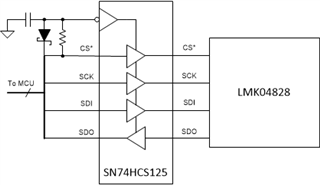Other Parts Discussed in Thread: SN74HCS125
Hello,
Could you please suggest techniques to mitigate high frequency noise on SPI lines. The details are below -
SPI frequency - 20MHz
Noise frequency ~1GHz @ -30dBc
Can we add RC filter for each SPI pin and place it close to the IC ? If yes, are there any drawbacks to this ?



